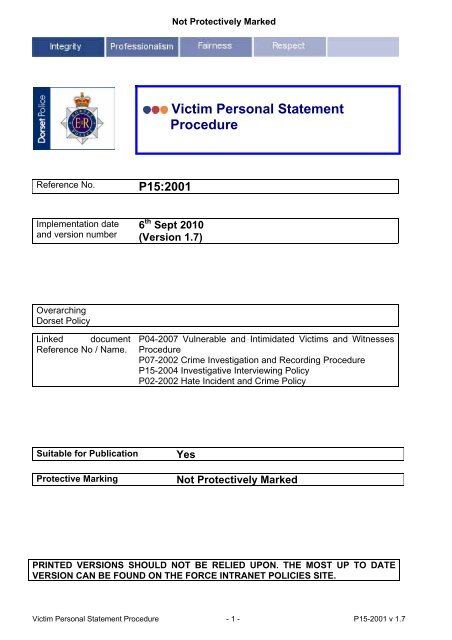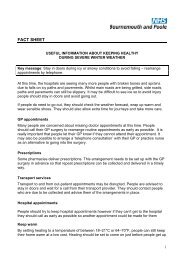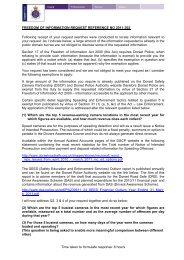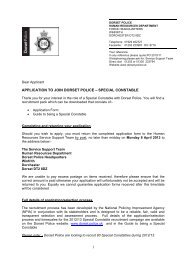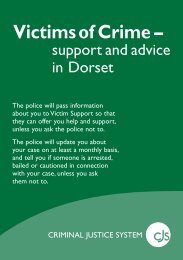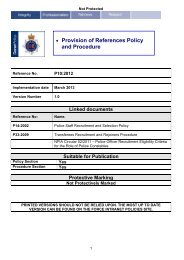Victims Personal Statement Procedure - Dorset Police
Victims Personal Statement Procedure - Dorset Police
Victims Personal Statement Procedure - Dorset Police
- No tags were found...
You also want an ePaper? Increase the reach of your titles
YUMPU automatically turns print PDFs into web optimized ePapers that Google loves.
Not Protectively MarkedVictim <strong>Personal</strong> <strong>Statement</strong><strong>Procedure</strong>Reference No. P15:2001Implementation dateand version number6 th Sept 2010(Version 1.7)Overarching<strong>Dorset</strong> PolicyLinked documentReference No / Name.P04-2007 Vulnerable and Intimidated <strong>Victims</strong> and Witnesses<strong>Procedure</strong>P07-2002 Crime Investigation and Recording <strong>Procedure</strong>P15-2004 Investigative Interviewing PolicyP02-2002 Hate Incident and Crime PolicySuitable for PublicationProtective MarkingYesNot Protectively MarkedPRINTED VERSIONS SHOULD NOT BE RELIED UPON. THE MOST UP TO DATEVERSION CAN BE FOUND ON THE FORCE INTRANET POLICIES SITE.Victim <strong>Personal</strong> <strong>Statement</strong> <strong>Procedure</strong> - 1 - P15-2001 v 1.7
Not Protectively MarkedContents1.0 Introduction 21.1 Document Aim 21.2 Visions and Values 22.0 Implications 22.1 Rationale and Legal Basis 22.2 People Focus and Risk Considerations 33.0 <strong>Procedure</strong> Content 33.1 When a Victim <strong>Personal</strong> <strong>Statement</strong> must be considered and initial actions 33.2 Child, vulnerable adult or intimidated victims 43.3 Taking a VPS at the same time as the witness statement 43.4 Taking a VPS at a later stage 63.5 Victim Focus Scheme 73.6 Action to be taken by the Criminal Justice Division upon receipt of a VPS 84.0 Monitoring/Feedback 85.0 Consultation/Quality Assurance/Authorisation 96.0 Version Control 91.0 Introduction1.1 Document AimTo provide a procedure for the taking of Victim <strong>Personal</strong> <strong>Statement</strong>s (VPS) and the useof the information contained within the VPS by the Criminal Justice Division and othercriminal justice agencies. The procedure will be supported by the following publicationsproduced by the Office for Criminal Justice Reform (OCJR):-• “Making a Victim <strong>Personal</strong> <strong>Statement</strong>” for victims;• “Victim <strong>Personal</strong> <strong>Statement</strong>s: A Guide for police officers, investigators and criminaljustice practitioners” for issue to all officers and staff who take statements;• “FAQs for VPS: For police officers and criminal justice practitioners”.1.2 Visions and Values<strong>Dorset</strong> <strong>Police</strong> is committed to the principles of “One Team, One Vision” – A Safer <strong>Dorset</strong>for You”. The Strategic priorities seek to achieve two clear objectives:-• To Make <strong>Dorset</strong> Safer – by focusing on current “Strategic Objectives”; and• To Make <strong>Dorset</strong> Feel Safer – by providing a service that is people focused.This document contributes to the strategic priorities by increasing public confidence in theCriminal Justice System and taking victims’ views into account.1.3 Public ConfidenceThe confidence of the public is central to our visions and value of “Making <strong>Dorset</strong> FeelSafer”All of our policy and procedure must encompass the following:Address individual needs and expectations?Reassure?Victim <strong>Personal</strong> <strong>Statement</strong> <strong>Procedure</strong> - 2 - P15-2001 v 1.7
Not Protectively Marked3.2.1 The following paragraphs in this section reflect the guidance contained in the 2007revision of the Criminal Justice System document ‘Achieving Best Evidence in CriminalProceedings’.3.2.2 Child, vulnerable adult or intimidated victims should be given the opportunity to make aVPS. The victim should be given an appropriate explanation about what a VPS is andhow it can and cannot be used, in order to help them make an informed choicewhether to make one or not. Child victims and their parents should be given an ageappropriateexplanation.3.2.3 In the first instance, child and vulnerable adult victims should be given an opportunityto make the statement themselves, but in some circumstances it may be appropriatefor the parent/carer to provide the VPS on the victim’s behalf. In some cases, it maybe necessary to take a VPS from both the victim and parent/carer in order to build up afull picture.3.2.4 Young victims over the age of 16 years of age are able to consent to making a VPS,but in the case of very young children or victims with a learning disability, considerationshould be given to consulting the parent/carer as to who should make the VPS.3.2.5 In cases where an intermediary is used to assist during the investigation/interviewingprocess, this can also include the making of a VPS if necessary.3.3 Taking a VPS at the same time as the witness statement3.3.1 If, after having received the explanation about the scheme and the booklet, the victimwishes to make a VPS at that stage, it should be taken by the officer taking theevidential witness statement.3.3.2 The VPS should form an additional section on the MG11 form at the end of the witnessstatement. It should be lined off and clearly separate from the main witness statement.The VPS should contain the following declaration:-“I have been given the “Making a Victim <strong>Personal</strong> <strong>Statement</strong>” leaflet and the Victim<strong>Personal</strong> <strong>Statement</strong> scheme has been explained to me. What follows is what I wish tosay in connection with this matter. I understand that what I say may be used in variousways and that it may be disclosed to the defence.”3.3.3 In the case of child, vulnerable adult or intimidated victims, the VPS should be taken inthe same format as the evidential witness statement. In cases where the witnessstatement has been taken in the form of a video-recorded interview, it is preferable forthe VPS to follow on the same recording, but there must be a clear break between thetwo.3.3.4 Full guidance on taking a VPS can be found in the booklet “Victim <strong>Personal</strong><strong>Statement</strong>s: A guide for police officers, investigators and criminal justice practitioners”.3.3.5 Officers may use the prompts contained within the VPS guide booklet referred to at3.3.4 (or alternatively those set out on the Victim <strong>Personal</strong> <strong>Statement</strong> pocket notebookinsert) to ensure that all potential issues are covered.Victim <strong>Personal</strong> <strong>Statement</strong> <strong>Procedure</strong> - 5 - P15-2001 v 1.7
Not Protectively Marked3.3.6 Officers should take the VPS as they would an evidential witness statement,questioning the victim in the same way, to help them express what they want to say.<strong>Victims</strong> should be encouraged to talk about their feelings by questioning. Officersshould bear in mind that every victim will be affected differently by crime (seeparagraph 3.1.4 above) and ensure that all relevant issues are explored and reflectedin the VPS if the victim wishes to include them.3.3.7 Following the taking of the VPS, the officer must take the following action:-• Assess any risks to the victim that may be identified in the VPS, or as a result ofother information, and take effective action to deal with any assessed risk afterconsultation with supervisors and other specialists;• Take any necessary immediate action to alleviate any distress or suffering ofthe victim. This may include the initial referral to Victim Support or other supportagencies;• Bring to the attention of the custody officer the contents of the VPS if anyone isin custody for the alleged offence against the victim at that time;• Keep the victim informed of the progress of the case by providing the updatesrequired by the <strong>Victims</strong>’ Code. This includes ensuring that the victim is notifiedof any Remand, Early First Hearing (EFH) or Early Administrative Hearing(EAH) court date. The victim will be kept updated as to subsequent court datesand other post charge information by the Witness Care Unit;• Input the fact that a VPS exists and details of any prompts that have beencovered in the VPS to the crime or collision recording system via the CentralInput Bureau dictation system;• Ensure that the VPS is linked to the other case papers as soon as possible.3.3.8 Following the taking of the VPS the Criminal Justice Division will ensure that allsubsequent necessary actions identified in the VPS, are carried out. This may includedealing with special needs if the case progresses to court, and notifying other criminaljustice agencies, primarily the Crown Prosecution Service, of the VPS and its content.3.3.9 If a VPS contains concerns of the victim about bail the Custody Officer must take theseinto consideration when making decisions about whether to grant bail or in determiningany conditions of bail that might be necessary to remove the need to detain a person incustody.3.4 Taking a VPS at a later stage3.4.1 A victim may ask to make a VPS at a later stage because they have changed theirmind about making one, or they may wish to describe the longer-term effects that thecrime has had on them or clarify anything said in an earlier VPS. The VPS can bemade at any time before the case is heard in court.3.4.2 The Case Director or CJD File Scrutineer will task the officer in the case to offer thevictim the opportunity to make a VPS if it appears from the file review to beappropriate.3.4.3 The Witness Care Officer (WCO) should also, as part of the detailed needsassessment, offer the victim the opportunity to make a VPS (or further VPS) at thatstage. The purpose of the detailed needs assessment is to explore a range of issuesVictim <strong>Personal</strong> <strong>Statement</strong> <strong>Procedure</strong> - 6 - P15-2001 v 1.7
Not Protectively Markedwhich may affect the victim’s attendance at court and their overall satisfaction with thecriminal justice process. The VPS therefore forms an important part of this process.3.4.4 The WCO should ensure that the victim (and/or any parent/carer) is aware of thescheme and has received an appropriate explanation, to include its purpose, benefitsand limitations, so that they are able to make an informed choice. The WCO should beaware of the issues set out in paragraph 3.1.4 above. Some of these issues mayemerge during the conversation between the WCO and the victim, or may have beenspecifically mentioned or indicated in an earlier VPS (which, if made, will be availableon NSPIS). If the victim wishes to make a VPS, the Witness Care Officer must contactthe officer in the case so that he/she can arrange for the VPS to be taken.3.4.5 Additionally, if a victim wishes to make a VPS, they can contact the officer in the casedirectly, using the details in the VPS leaflet given to them. The officer in the case andany other member of staff who becomes aware that a victim wishes to make a VPSmust act promptly to ensure that it is taken and can be acted on before any courtproceedings.3.4.6 A VPS may be taken at this stage either by the officer in the case or another officer,such as a Detained Persons Unit Enquiry Officer. It may be taken at the victim’shome, at the police station or any other mutually acceptable place. Before taking theVPS the officer must check the case progress with the Criminal Justice Division. If thecase has progressed as far as charging an alleged offender, the CPS should beconsulted by the CJD File Scrutineer to see if there are any ‘case handling’ issues tobe borne in mind.3.4.7 Guidance on taking a VPS can be found in the booklet “Victim <strong>Personal</strong> <strong>Statement</strong>s: AGuide for police officers, investigators and criminal justice practitioners”. Officers arealso referred to the guidance at paragraph 3.3.6 above.3.4.8 The officer must remind the victim about the key points of making a VPS and ensurethat the victim understands the implications of making the statement, in particular thefact that it cannot be withdrawn and that it will form part of the case papers and bedisclosable to the defence.3.4.9 The VPS should be taken in a written format on a new MG11. In the case of child,vulnerable adult or intimidated victims, the VPS should also be taken in a writtenformat unless there are exceptional circumstances.3.4.10 The VPS should contain the following declaration:-“I have been given the “Making a Victim <strong>Personal</strong> <strong>Statement</strong>” leaflet and the Victim<strong>Personal</strong> <strong>Statement</strong> scheme has been explained to me. What follows is what I wish tosay in connection with this matter [*in addition to what I said in my previous Victim<strong>Personal</strong> <strong>Statement</strong>]. I understand that what I say may be used in various ways andthat it may be disclosed to the defence.” *Delete if not applicable.3.4.11 The victim should be asked to explain briefly in the VPS why they are making astatement, for example because:-• The longer-term effects of the crime are only now becoming apparent;• There has been a greater or lesser financial loss; orVictim <strong>Personal</strong> <strong>Statement</strong> <strong>Procedure</strong> - 7 - P15-2001 v 1.7
Not Protectively Marked• The victim wishes to express legitimate concerns, such as feeling vulnerable,fearful, intimidated or worried about the alleged offender being granted bail.3.4.12 After completion of the VPS the officer taking it must:-• Assess any risks to the victim that may be identified in the VPS, or as a result ofother information, and take effective action to deal with any assessed risk afterconsultation with supervisors and other specialists;• Take any necessary immediate action to alleviate any distress or suffering of thevictim. This may include the secondary referral to Victim Support or othersupport agencies;• Input the fact that the VPS exists and any details of prompts that have beencovered in the VPS to the crime or accident recording system via the CentralInput Bureau dictation system;• Ensure that it is linked to the other case papers as soon as possible, if necessarypassing it to the relevant CJD File Preparation Unit under cover of the relevantfile Unique Reference Number (URN).3.5 Victim Focus Scheme3.5.1 Under the Victim Focus Scheme, prosecutors will offer to meet bereaved families incertain specified cases (as detailed in paragraph 3.5.2 below) after charge, in order toexplain to them the role of the CPS, the legal basis of the charges on which theprosecution is proceeding, the court process, progress of the case and the Victim<strong>Personal</strong> <strong>Statement</strong> scheme.3.5.2 The categories of offences currently included in the scheme (“qualifying offences”)are:-• Murder;• Manslaughter;• Corporate manslaughter;• Familial homicide;• Causing death by dangerous driving;• Causing death by careless driving while unfit through drink or drugs;• Aggravated vehicle taking where death is caused (where the case is heard in theCrown Court).3.5.3 At the meeting with the family, the CPS prosecutor will explain the Victim <strong>Personal</strong><strong>Statement</strong> scheme. Some family members may already have made a VPS before themeeting takes place, but others may not. Prosecutors should explain the purpose ofthe VPS scheme and that it is open to family members to make a further VPS closer tothe date of the trial if they wish.3.5.4 The Family Liaison Officer (FLO) appointed to the case will be responsible for takingand drafting the VPS. The prosecutor must not be involved in this process.3.5.5 Multiple victim personal statements should generally be avoided if possible. Onemeans of achieving this is for one family member to formally adopt a composite VPSthat refers to the impact on other family members.Victim <strong>Personal</strong> <strong>Statement</strong> <strong>Procedure</strong> - 8 - P15-2001 v 1.7
Not Protectively Marked5.0 Consultation / Quality Assurance / Authorisation<strong>Police</strong> FederationName Signature DateSuperintendentsAssociationUnisonOtherPartnersRelevantAuthorisation of this versionThis Version Name Signature Date(v1.7)Prepared: Sarah Chaloner 23/08/10Quality assured: Mrs Jan Steadman 23/08/10ImpactN/AAssessmentQuestionnaireCompleted:Authorised: Chief SuperintendentDonnellApproved: N/A31/08/106.0 Version Control6.1 ReviewEvery policy or procedure is subject to two processes of continuing review:-• A general review of its continuing relevance and accuracy called a Review ofPurpose.• An audit review of its current impact in relation to diversity called a Review ofImpact.DateNext Review of Purpose 01/08/2012Next Review of Impact 01/08/20136.2 Version HistoryVictim <strong>Personal</strong> <strong>Statement</strong> <strong>Procedure</strong> - 10 - P15-2001 v 1.7
Not Protectively MarkedVersion Date Reason for Change Amended by1.0 180801 Initial Policy Document1.1 060901 Following further discussions at Superintendent SummersCJD1.2 190901 Following submission from Superintendent SummersProfessional Standards1.3 240305 Reformatting Ms M Ashdown1.4 240708 Minor amendments, to include Sarah Chalonerreference to the Victim FocusScheme. Change from policyto procedure and transfer tonew format.1.5 260808 Further minor amendments as Sarah Chalonerresult of impact assessment.1.6 081209 Review and updating following Sarah ChalonerOCJR review and production ofguidance/toolkit1.7 110810 Minor amendments followingEqualities and Human RightsCommission national reportSarah Chaloner6.3 Document HistoryACCHead of Criminal Justice DivisionCriminal Justice DivisionSOPGPortfolio HolderDocument OwnerOwning DepartmentVersion 1.0 Approved atv1.0 Approval Date 20/09/2001v1.0 Approved by Chief Constablev1.0 ImplementationDate01/10/2001Victim <strong>Personal</strong> <strong>Statement</strong> <strong>Procedure</strong> - 11 - P15-2001 v 1.7


